Shikui Tu
DEPTH: Hallucination-Free Relation Extraction via Dependency-Aware Sentence Simplification and Two-tiered Hierarchical Refinement
Aug 20, 2025Abstract:Relation extraction enables the construction of structured knowledge for many downstream applications. While large language models (LLMs) have shown great promise in this domain, most existing methods concentrate on relation classification, which predicts the semantic relation type between a related entity pair. However, we observe that LLMs often struggle to reliably determine whether a relation exists, especially in cases involving complex sentence structures or intricate semantics, which leads to spurious predictions. Such hallucinations can introduce noisy edges in knowledge graphs, compromising the integrity of structured knowledge and downstream reliability. To address these challenges, we propose DEPTH, a framework that integrates Dependency-aware sEntence simPlification and Two-tiered Hierarchical refinement into the relation extraction pipeline. Given a sentence and its candidate entity pairs, DEPTH operates in two stages: (1) the Grounding module extracts relations for each pair by leveraging their shortest dependency path, distilling the sentence into a minimal yet coherent relational context that reduces syntactic noise while preserving key semantics; (2) the Refinement module aggregates all local predictions and revises them based on a holistic understanding of the sentence, correcting omissions and inconsistencies. We further introduce a causality-driven reward model that mitigates reward hacking by disentangling spurious correlations, enabling robust fine-tuning via reinforcement learning with human feedback. Experiments on six benchmarks demonstrate that DEPTH reduces the average hallucination rate to 7.0\% while achieving a 17.2\% improvement in average F1 score over state-of-the-art baselines.
Non-Linear Flow Matching for Full-Atom Peptide Design
Feb 21, 2025Abstract:Peptide design plays a pivotal role in therapeutic applications, yet existing AI-assisted methods often struggle to generate stable peptides with high affinity due to their inability to accurately simulate the dynamic docking process. To address this challenge, we propose NLFlow, a novel multi-manifold approach based on non-linear flow matching. Specifically, we design a polynomial-based conditional vector field to accelerate the convergence of the peptide's position towards the target pocket, effectively capturing the temporal inconsistencies across position, rotation, torsion, and amino acid type manifolds. This enables the model to better align with the true conformational changes observed in biological docking processes. Additionally, we incorporate interaction-related information, such as polarity, to enhance the understanding of peptide-protein binding. Extensive experiments demonstrate that NLFlow outperforms existing methods in generating peptides with superior stability, affinity, and diversity, offering a fast and efficient solution for peptide design and advancing the peptide-based therapeutic development.
Towards Generalizable Reinforcement Learning via Causality-Guided Self-Adaptive Representations
Jul 31, 2024Abstract:General intelligence requires quick adaption across tasks. While existing reinforcement learning (RL) methods have made progress in generalization, they typically assume only distribution changes between source and target domains. In this paper, we explore a wider range of scenarios where both the distribution and environment spaces may change. For example, in Atari games, we train agents to generalize to tasks with different levels of mode and difficulty, where there could be new state or action variables that never occurred in previous environments. To address this challenging setting, we introduce a causality-guided self-adaptive representation-based approach, called CSR, that equips the agent to generalize effectively and efficiently across a sequence of tasks with evolving dynamics. Specifically, we employ causal representation learning to characterize the latent causal variables and world models within the RL system. Such compact causal representations uncover the structural relationships among variables, enabling the agent to autonomously determine whether changes in the environment stem from distribution shifts or variations in space, and to precisely locate these changes. We then devise a three-step strategy to fine-tune the model under different scenarios accordingly. Empirical experiments show that CSR efficiently adapts to the target domains with only a few samples and outperforms state-of-the-art baselines on a wide range of scenarios, including our simulated environments, Cartpole, and Atari games.
Boosting Efficiency in Task-Agnostic Exploration through Causal Knowledge
Jul 30, 2024



Abstract:The effectiveness of model training heavily relies on the quality of available training resources. However, budget constraints often impose limitations on data collection efforts. To tackle this challenge, we introduce causal exploration in this paper, a strategy that leverages the underlying causal knowledge for both data collection and model training. We, in particular, focus on enhancing the sample efficiency and reliability of the world model learning within the domain of task-agnostic reinforcement learning. During the exploration phase, the agent actively selects actions expected to yield causal insights most beneficial for world model training. Concurrently, the causal knowledge is acquired and incrementally refined with the ongoing collection of data. We demonstrate that causal exploration aids in learning accurate world models using fewer data and provide theoretical guarantees for its convergence. Empirical experiments, on both synthetic data and real-world applications, further validate the benefits of causal exploration.
PFB-Diff: Progressive Feature Blending Diffusion for Text-driven Image Editing
Jun 28, 2023



Abstract:Diffusion models have showcased their remarkable capability to synthesize diverse and high-quality images, sparking interest in their application for real image editing. However, existing diffusion-based approaches for local image editing often suffer from undesired artifacts due to the pixel-level blending of the noised target images and diffusion latent variables, which lack the necessary semantics for maintaining image consistency. To address these issues, we propose PFB-Diff, a Progressive Feature Blending method for Diffusion-based image editing. Unlike previous methods, PFB-Diff seamlessly integrates text-guided generated content into the target image through multi-level feature blending. The rich semantics encoded in deep features and the progressive blending scheme from high to low levels ensure semantic coherence and high quality in edited images. Additionally, we introduce an attention masking mechanism in the cross-attention layers to confine the impact of specific words to desired regions, further improving the performance of background editing. PFB-Diff can effectively address various editing tasks, including object/background replacement and object attribute editing. Our method demonstrates its superior performance in terms of image fidelity, editing accuracy, efficiency, and faithfulness to the original image, without the need for fine-tuning or training.
Linking Sketch Patches by Learning Synonymous Proximity for Graphic Sketch Representation
Nov 30, 2022



Abstract:Graphic sketch representations are effective for representing sketches. Existing methods take the patches cropped from sketches as the graph nodes, and construct the edges based on sketch's drawing order or Euclidean distances on the canvas. However, the drawing order of a sketch may not be unique, while the patches from semantically related parts of a sketch may be far away from each other on the canvas. In this paper, we propose an order-invariant, semantics-aware method for graphic sketch representations. The cropped sketch patches are linked according to their global semantics or local geometric shapes, namely the synonymous proximity, by computing the cosine similarity between the captured patch embeddings. Such constructed edges are learnable to adapt to the variation of sketch drawings, which enable the message passing among synonymous patches. Aggregating the messages from synonymous patches by graph convolutional networks plays a role of denoising, which is beneficial to produce robust patch embeddings and accurate sketch representations. Furthermore, we enforce a clustering constraint over the embeddings jointly with the network learning. The synonymous patches are self-organized as compact clusters, and their embeddings are guided to move towards their assigned cluster centroids. It raises the accuracy of the computed synonymous proximity. Experimental results show that our method significantly improves the performance on both controllable sketch synthesis and sketch healing.
IA-FaceS: A Bidirectional Method for Semantic Face Editing
Mar 25, 2022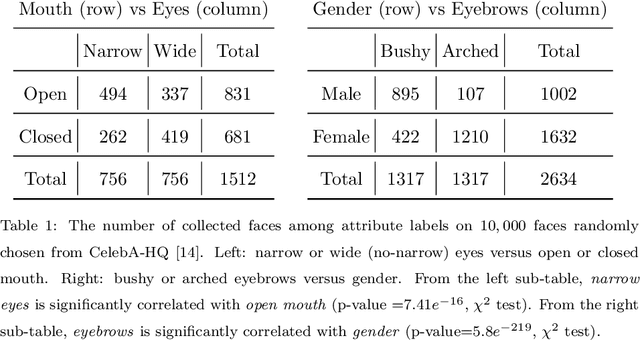
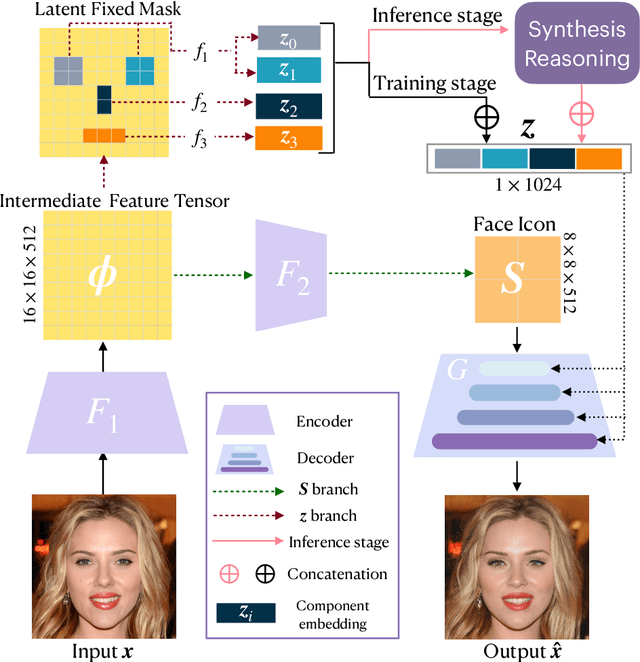
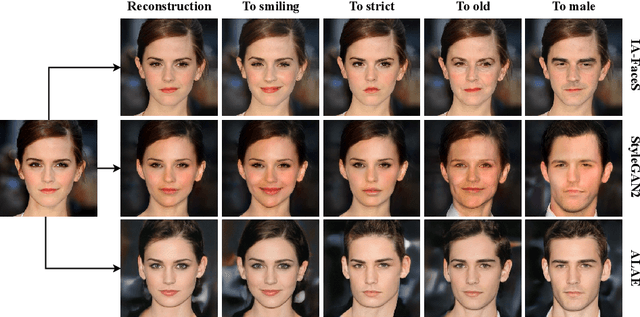
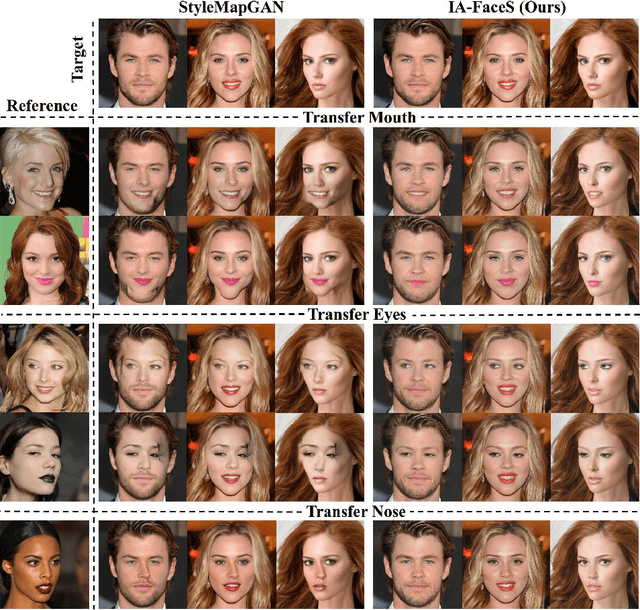
Abstract:Semantic face editing has achieved substantial progress in recent years. Known as a growingly popular method, latent space manipulation performs face editing by changing the latent code of an input face to liberate users from painting skills. However, previous latent space manipulation methods usually encode an entire face into a single low-dimensional embedding, which constrains the reconstruction capacity and the control flexibility of facial components, such as eyes and nose. This paper proposes IA-FaceS as a bidirectional method for disentangled face attribute manipulation as well as flexible, controllable component editing without the need for segmentation masks or sketches in the original image. To strike a balance between the reconstruction capacity and the control flexibility, the encoder is designed as a multi-head structure to yield embeddings for reconstruction and control, respectively: a high-dimensional tensor with spatial properties for consistent reconstruction and four low-dimensional facial component embeddings for semantic face editing. Manipulating the separate component embeddings can help achieve disentangled attribute manipulation and flexible control of facial components. To further disentangle the highly-correlated components, a component adaptive modulation (CAM) module is proposed for the decoder. The semantic single-eye editing is developed for the first time without any input visual guidance, such as segmentation masks or sketches. According to the experimental results, IA-FaceS establishes a good balance between maintaining image details and performing flexible face manipulation. Both quantitative and qualitative results indicate that the proposed method outperforms the other techniques in reconstruction, face attribute manipulation, and component transfer.
Deep Rival Penalized Competitive Learning for Low-resolution Face Recognition
Aug 03, 2021



Abstract:Current face recognition tasks are usually carried out on high-quality face images, but in reality, most face images are captured under unconstrained or poor conditions, e.g., by video surveillance. Existing methods are featured by learning data uncertainty to avoid overfitting the noise, or by adding margins to the angle or cosine space of the normalized softmax loss to penalize the target logit, which enforces intra-class compactness and inter-class discrepancy. In this paper, we propose a deep Rival Penalized Competitive Learning (RPCL) for deep face recognition in low-resolution (LR) images. Inspired by the idea of the RPCL, our method further enforces regulation on the rival logit, which is defined as the largest non-target logit for an input image. Different from existing methods that only consider penalization on the target logit, our method not only strengthens the learning towards the target label, but also enforces a reverse direction, i.e., becoming de-learning, away from the rival label. Comprehensive experiments demonstrate that our method improves the existing state-of-the-art methods to be very robust for LR face recognition.
Solve Traveling Salesman Problem by Monte Carlo Tree Search and Deep Neural Network
May 14, 2020



Abstract:We present a self-learning approach that combines deep reinforcement learning and Monte Carlo tree search to solve the traveling salesman problem. The proposed approach has two advantages. First, it adopts deep reinforcement learning to compute the value functions for decision, which removes the need of hand-crafted features and labelled data. Second, it uses Monte Carlo tree search to select the best policy by comparing different value functions, which increases its generalization ability. Experimental results show that the proposed method performs favorably against other methods in small-to-medium problem settings. And it shows comparable performance as state-of-the-art in large problem setting.
Revisit Lmser and its further development based on convolutional layers
Apr 12, 2019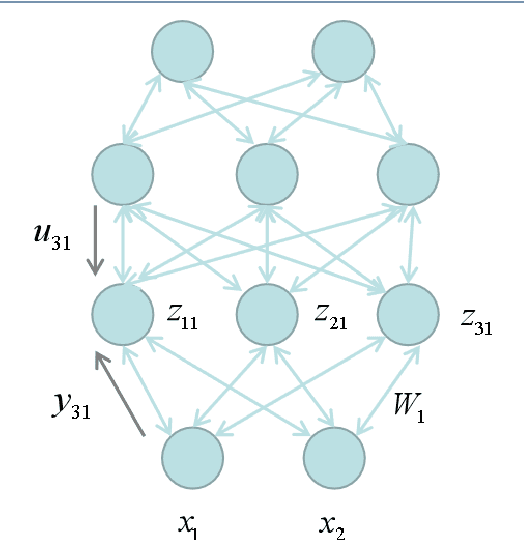

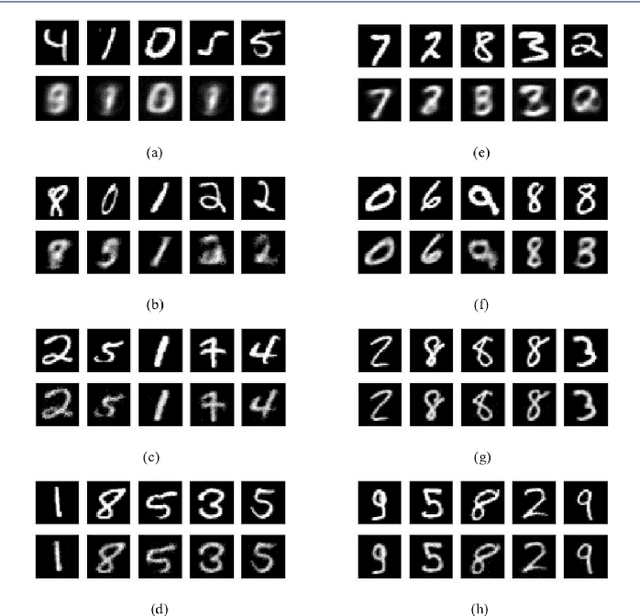
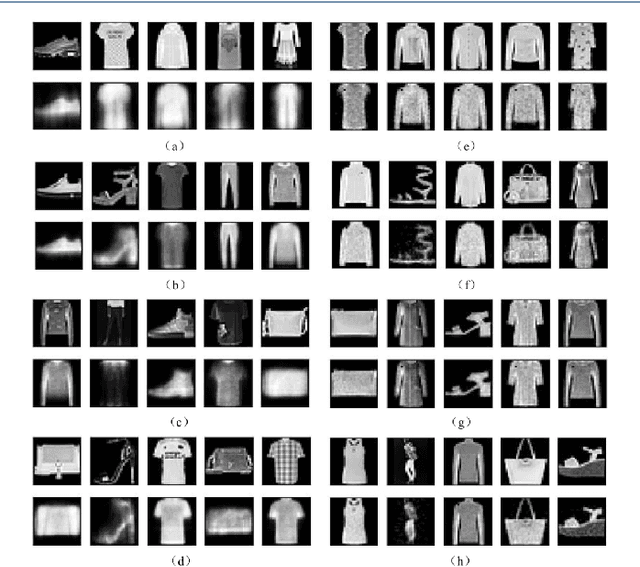
Abstract:Proposed in 1991, Least Mean Square Error Reconstruction for self-organizing network, shortly Lmser, was a further development of the traditional auto-encoder (AE) by folding the architecture with respect to the central coding layer and thus leading to the features of symmetric weights and neurons, as well as jointly supervised and unsupervised learning. However, its advantages were only demonstrated in a one-hidden-layer implementation due to the lack of computing resources and big data at that time. In this paper, we revisit Lmser from the perspective of deep learning, develop Lmser network based on multiple convolutional layers, which is more suitable for image-related tasks, and confirm several Lmser functions with preliminary demonstrations on image recognition, reconstruction, association recall, and so on. Experiments demonstrate that Lmser indeed works as indicated in the original paper, and it has promising performance in various applications.
 Add to Chrome
Add to Chrome Add to Firefox
Add to Firefox Add to Edge
Add to Edge